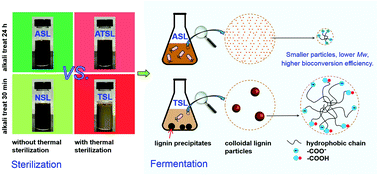Elucidating the mechanisms of enhanced lignin bioconversion by an alkali sterilization strategy†
Abstract
Biological lignin valorization represents an emerging green approach to upgrade lignin for sustainable and economic biorefineries. However, lignin generally exhibits poor water solubility and inhomogeneous distribution in an aqueous medium, significantly limiting its bioconversion efficiency. Herein, we develop a novel alkali sterilization strategy to effectively enhance the dispersion and fermentation performance of lignin substrates. The colloidal particle size and molecular structure variations of lignin during the sterilization were thoroughly investigated to reveal the mechanisms of enhanced fermentation performance. Results showed that alkali sterilization achieved a completely aseptic effect when mixing lignin medium at an initial pH of 12.7 for 24 h. Dynamic light scattering (DLS) analysis demonstrated that the hydrodynamic volume of colloidal lignin particles decreased by 96.3% by alkali sterilization compared with the conventional thermal sterilization. Moreover, lignin characterizations by nuclear magnetic resonance (NMR) spectroscopy and gel permeation chromatography (GPC) suggested that alkali sterilization modified the lignin molecular structure by generating 50% more hydrophilic carboxyl groups, reducing the weight-average molecular weight (Mw) by 23.0%, and narrowing the molar-mass dispersity (ĐM) by 23.8%. The generation of lignin substrates with more uniform distribution and lower molecular weight improved Rhodococcus opacus PD630 cell growth and metabolism. Microbial cell amount, lignin degradation, and lipid production in alkali sterilized medium increased by 309%, 30.3%, and 48.3%, respectively, compared to those in thermally sterilized medium. These results clearly demonstrated that alkali sterilization dramatically improved the lignin bioconversion performance. This work presents a facile and effective sterilization strategy to overcome inhomogeneous lignin distribution in aqueous fermentation media, showing great potentials as a platform technique for promoting biological lignin valorization.



 Please wait while we load your content...
Please wait while we load your content...